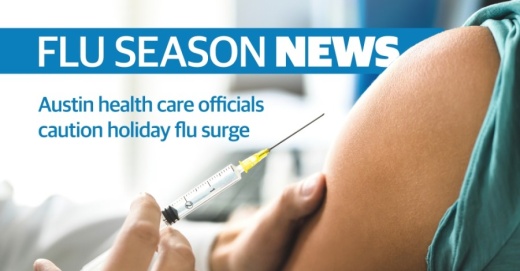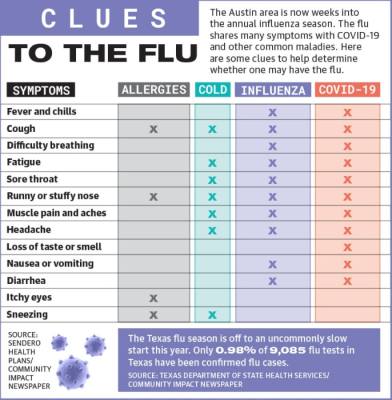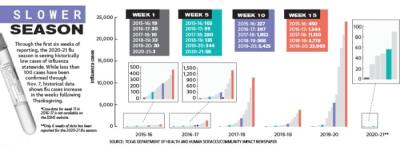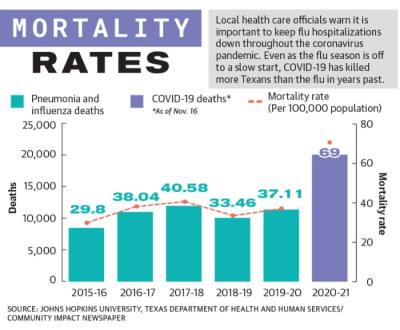“When we first started to understand what we were dealing with, with COVID-19, we realized it wasn’t going anywhere. There was a lot of collective anxiety back then about what’s going to happen when the flu gets here,” Charbeneau said.
In the time since, local health care officials and other authorities have met regularly to begin planning for the flu season, according to Charbeneau, the chief medical officer of St. David’s North Austin Medical Center. Now, with early numbers on the flu season coming in and a clearer picture of how the public can prevent widespread coronavirus and flu hospitalizations simultaneously, Charbeneau said he is feeling cautiously optimistic about the upcoming months.
“I’m feeling fairly confident about the flu not being a problem this year,” he said.
Still, St. David’s officials, along with other local health care experts who spoke to Community Impact Newspaper, caution that the public needs to remain vigilant in preventing the flu from becoming a widespread problem.
Now in the full swing of the holiday season and with national coronavirus cases reaching record highs in November, the potential is still present for health care systems to become overwhelmed with simultaneous coronavirus and flu hospitalizations.
“If we get the [COVID-19] surges they’re seeing out in El Paso, Wisconsin or Italy ... we can be in trouble,” Charbeneau said.
Flu season starting slow
The 2020 flu season in Texas is off to a sluggish start compared to years past, state numbers show.
According to the Texas Department of State Health Services, through the week ending Nov. 7, a total of 89 Texans have been diagnosed with influenza.
That is the lowest number of cases through the first six weeks of reporting in at least six years. At this time last year, 396 cases had been reported. While more influenza tests were reported last year, this year’s positivity rate of administered tests—0.98%—remains much lower than it was at this point last year—3.43%.
While the number of flu cases remains low, the DSHS notes that the majority of flu cases in Texas are not reportable by law. DSHS data contains flu cases reported only to public health agencies.
There are likely several reasons Texas is experiencing notably depressed confirmed cases to begin the annual flu season this year.
Precautions taken to prevent the spread of the coronavirus, such as social distancing, masking and wearing gloves, are also effective in fighting the spread of the flu.
Further, more people in Austin seem to be seeking out flu shots.
Austin Regional Clinic has reported a 43.54% increase in administered flu vaccinations from August through October compared to that time last year, according to data provided to Community Impact Newspaper.
“There has definitely been a significant uptick of people coming in for vaccinations, which is good to see,” said Dr. Manish Naik, chief medical information officer at ARC. “I think people are more concerned and cautious because of COVID-19.”
ARC this year launched a new drive-thru vaccination service for patients apprehensive about going into waiting rooms. Since launching this service, approximately 12% of ARC’s flu shots are done via drive-thru.
An Oct. 31 community event organized by Sendero Health Plans, Austin Public Health, Austin ISD and other community partners administered 200 flu shots in just three hours, said Rudy Ybarra, director of business development for Sendero.
“The demand was there. Folks were lined up before the event started,” Ybarra said.
Sendero, a nonprofit health care insurer funded by Central Health, was on-site at the event and distributed 700 COVID-19 prevention kits with masks, sanitizer and health care information pamphlets to everyone who attended, including families and volunteers who may not have received flu shots.
Dr. Mary Carol Jennings, who joined Sendero as its chief medical officer in August, said the materials will potentially help to reinforce disease-prevention efforts in Austin.
“I hope the extra attention we’re getting on better behaviors from the pandemic will have a secondary effect on flu cases,” Jennings said.
So far, it seems to be working. According to weekly flu reports from APH, there were fewer than a dozen positive flu cases across Travis County through the first week of November. Holiday surge concerns
Even as flu cases remain low locally and statewide, there is some alarm among medical professionals that a bump could occur following upcoming holiday breaks. Most concerning, that bump could occur as coronavirus cases peak following record-setting case counts in the U.S.
According to DSHS data, confirmed flu cases last year jumped 24.54% in the week after Thanksgiving and jumped again by 31.56% in the week following Christmas.
The flu spreads similarly to the coronavirus, Naik said, and is likely to be passed among individuals who spend time with one another in closed quarters for extended periods of time. As students return home from college campuses and families travel to spend the holidays with each other, the chance to spread the flu—and COVID-19—rises.
“It could become a challenge if both of those viral infections see an upswing at the same time,” Naik said. “If people are really good about masking and distancing and keeping gatherings small, then I think we’ll see less of an impact.”
There is a possibility that flu and coronavirus cases peak at the same time locally. APH on Nov. 14 reported 300 new cases of coronavirus, the highest single-day number of cases since mid-August. The U.S. Centers for Disease Control and Prevention on Nov. 13 announced a record high number of daily new cases nationwide—more than 181,000. Hospital admissions are likewise climbing.
Charbeneau said competing local hospital systems are communicating daily with one another and local health authorities to manage caseloads, but an overwhelmed system could lead to scenarios where the Austin Convention Center opens as a field hospital. It is possible that health care professionals from other parts of the country would need to travel to Austin to help manage the caseload, Charbeneau added, just as Austin is sending nurses and doctors to places like El Paso now.
“There is a fatigue that settles in, and we have to be mindful of supporting our medical staff. Taking care of sick and dying people is hard work,” he said. Fighting the flu
Individuals in Central Texas can help keep local flu cases and infections at a low rate through one simple action—get the influenza vaccine, Naik said.
While an inoculation is not fully guaranteed to prevent the flu, it does greatly reduce chances for patients to contract the virus throughout flu season. Naik said getting the flu vaccine is doubly important this year, as it helps prevent severe cases of the flu.
“The flu vaccine very clearly reduces the likelihood of someone getting very sick or hospitalized from the flu,” Naik said.
That community buy-in may prove necessary if coronavirus cases continue to climb. As of Nov. 14, more than 20,000 Texans have died of complications related to COVID-19, per Johns Hopkins University. That is 68% higher than the number of deaths in the 2017-18 flu season, Texas’ deadliest in at least six years.
Keeping hospital beds open and patient caseloads down can help maintain a high level of care for at-risk coronavirus patients who are hospitalized. Getting the flu vaccine this year, Jennings said, may help accomplish that goal.
“It’s an individual’s decision, but for those that typically don’t get the flu vaccine, with what we are going through this year, we hope they reconsider,” Jennings said.









